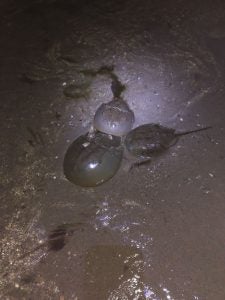Assessing Atlantic Horseshoe Crab (Limulus polyphemus) Population Structure within Southern New England
 Principal Investigator: Natalie Ameral (URI CELS/RI DEM), Jonathan Puritz (URI CELS)
Principal Investigator: Natalie Ameral (URI CELS/RI DEM), Jonathan Puritz (URI CELS)
Collaborators: Conor Mcmanus (RI DEM), Scott Olszewski (RI DEM), Kim Gaffett (RINHS/TNC), Diandra Verbeyst (TNC)
Funding Source: U.S. Fish and Wildlife State Wildlife Grant
Through collaboration between the Rhode Island Department of Environmental Management’s Division of Marine Fisheries and the University of Rhode Island, this project team aims to assess population structure of horseshoe crabs in Rhode Island and nearby waters using a multidisciplinary approach. The goal of this research is to ascertain whether there are discrete, segregated populations of horseshoe crabs in Rhode Island waters, how different they are from other Southern New England states, and whether there is mixing between spawning contingents. Crabs will be assessed at sites with their associated environmental data collected, have genetic samples taken from the crabs, and released with a tag. Molecular analyses will confirm whether physically segregated crabs are genetically different or unique to the water bodies they inhabit. Phenotypic and environmental data collected for crabs genetically sampled will provide inference on how prospective genetic differences relate to the crabs’ niches. The tagging portion of this project will demonstrate on a more tangible and individualized scale crab mixing rates between water bodies and their degree of site fidelity. The data produced by this project can be used by the state of Rhode Island and the Atlantic States Marine Fisheries Commission to make informed decisions on management actions for horseshoe crabs both in state and on a coastwide scale toward preserving the stock.
 Home
Home Browse
Browse Close
Close Events
Events Maps
Maps Email
Email Brightspace
Brightspace eCampus
eCampus


